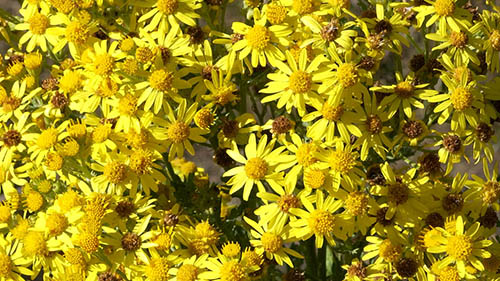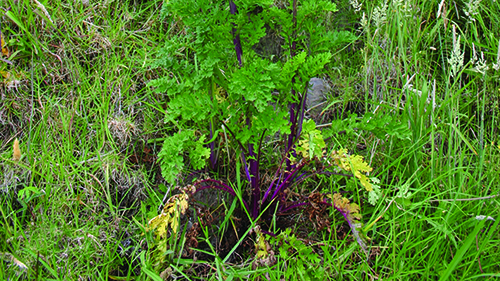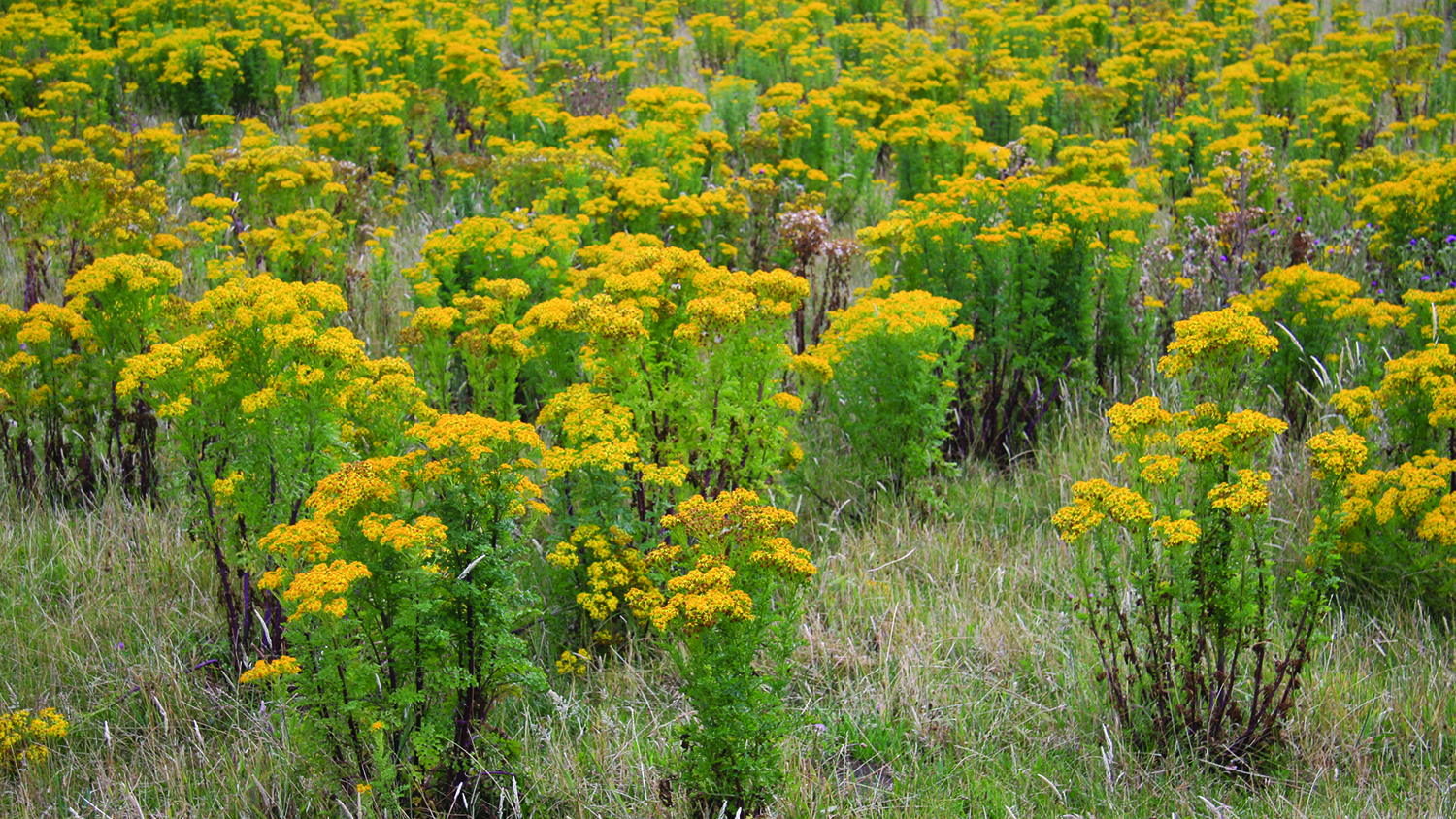| Management programme |
| Sustained control |
| Objectives |
| Keep ragwort from affecting nearby land clear or being cleared of it. |
| Impacts |
| Economic, animal welfare |
Ragwort, a native to Europe and western Asia, was originally introduced to New Zealand in the 1890s as a garden plant. However, it has been long been recognised as an invasive agricultural pest plant. It has unpalatable foliage that is poisonous to stock, with heavy infestations able to reduce pasture production throughout New Zealand.


What does it look like?
An erect biennial or perennial daisy, ragwort grows to between 45CM-60cm high (but can reach up to 2m). It has masses of yellow flowers. Juvenile plants can be difficult to recognise as their leaves look different to those of mature plants. Ragwort plants have an unpleasant smell when crushed.
Flower
- Bright yellow flowerheads (2cm across) clustered at the end of branches.
- Flowerheads are clusters of ray (outer petals) and disk (flat central flowers) florets.
- Flower stems can grow to 1.2m tall.
- Flowering is from November to April.
Fruit/seed
- Parachute-like light coloured seed (achene) attached to fine hairs (pappus).
- The fine hairs open out, forming a fluffy ball (thistle-down).
- The hairs on each seed catch in the wind, aiding seed dispersal.
Leaves/stem
- Young ragwort plants are a flat rosette of dark green leaves with large lobes.
- As plants get older and form a stem, the leaves become deeply dissected.
- Stems are purple.
- Flowering stems, and in some places, the whole plant die back in autumn.
Why is it a pest?
While ragwort is primarily a pasture weed, it is also commonly found in waste places, coastal areas, riparian margins, shrubland, open forests and swamps. Once established, ragwort can spread rapidly and invade clean pasture. Heavy infestations of ragwort reduce pasture production, in turn reducing the farm’s carrying capacity and imposing farm management costs on the occupier. It spreads readily over long distances via its wind-dispersed seeds. Seeds can also be spread via machinery and stock.
Ragwort is more apparent on dairying and dry stock properties, where it is harmful to grazing cattle, deer and horses causing liver damage (cirrhosis), photosensitisation (skin inflammation), jaundice and weight loss. It can also cause skin irritation and allergies to humans when handled extensively.
Cinnabar moth was released in the 1920s as a biological control agent for ragwort to reduce infestations of it throughout the country. Two other agents, the ragwort flea beetle (released widely during the late 1980s and early 1990s) and ragwort plume moth (releases began in 2006) are also helping to reduce ragwort infestations in New Zealand.
Control methods
Physical control
Pulling plants out and disposing of them by deeply burying, burning or composting (if no seed heads are present) is an effective method of controlling ragwort. Plants are best pulled at the flowering stage where the roots are much less likely to regrow. Mowing ragwort is not recommended, as it will encourage the plant to become multi-crowned or to become a perennial plant, making it difficult to control. Ragwort is poisonous to cattle and horses but not sheep, so stocking ragwort-infested areas with sheep will reduce the number of plants.
Grazing management
Ragwort can be grazed by sheep or goats. However, cattle rarely eat ragwort seedlings or rosettes.
- Damage to pasture cover or soil disturbance increases ragwort seed germination.
- Continuous grazing, as opposed to rotational grazing, is more likely to lead to ragwort infestations. Under continuous stocking livestock can graze selectively, which can lead to overgrazing and ragwort establishment.
- Once the seedling has formed a rosette, it competes well with grasses and clovers. At this stage, only tall pastures such as a hay crop may reduce its growth.
Pasture species/cultivars
- Maintaining a dense, vigorous pasture can help prevent ragwort germination and establishment.
- This can be helped by appropriate stocking rates, irrigation and fertiliser.
- Superphosphate and urea applications have both been shown to increase pasture growth and suppress ragwort.
Mowing or grubbing
- Small patches of plants can be removed by hand or grubbing. However, plants can regrow from root fragments left in the ground.
- Pulled plants should be removed and burned so viable seed does not spread.
- Larger plants have deep root systems, making it hard to remove all the roots. However, as plants get older, regrowth from root segments is less likely.
- If plants are mown, they can regrow and produce multi-crowned plants, each crown with stems. This may prolong the life of the plant and turn it from a biennial to a perennial.
- Mowing or cutting repeatedly, in combination with appropriate fertilisers, can favour grass growth and help prevent ragwort from establishing.
Ploughing
- For large infestations, deep ploughing followed by summer and autumn cultivations can kill ragwort plants, regrowth and seedlings.
Integrated pest management
- Older plants may be hard to kill. However, one technique is to leave them to die naturally in ungrazed areas, followed by grazing, spot-spraying and maintaining a dense pasture to control the seedlings.
Herbicide control
There are many herbicides that will control ragwort. The herbicide best suited to your property will depend on the level of infestation, the application equipment you have available and the stage of growth the plants are at. Some suggested herbicides are included in the table in this factsheet. Contact your local biosecurity pest plant officer for free advice on what herbicide and application method would best suit your situation on freephone 0800 800 401.
Spray application
A boom/aerial application of herbicide will affect desirable species such as clover and ryegrass. This damage can be minimised by applying herbicide to ragwort plants in the seedling/rosette stage during autumn and early winter. Be aware that ragwort plants may become more palatable to cattle and horses after spraying. Stock should be removed until the treated plants die.
Small block owners who may not have access to spray equipment could consider physical control methods (see above) or select a herbicide such as picloram granules. Picloram is a dry application powder which does not require mixing or spray equipment.
Herbicide control tips
- Young plants in the rosette stage are easier to control than older plants.
- 2,4-D is more effective on younger than older plants (including older rosettes, budding or flowering plants).
- 2,4-D and MCPA damage clover. Some products used to control ragwort also damage grasses.
- Check regarding withholding periods for the chemicals used. There may be a withholding period of up to several weeks before stock are allowed back onto the pasture.
Safety when using herbicides
- Follow the instructions on the manufacturer’s label.
- Always wear protective clothing.
- Always minimise the risk to your other plants.
- Contact the supplier for further advice.
- Consult your farm consultant, industry rep or New Zealand Novachem Agrichemical Manual for more information about chemical control.
Summary of herbicides and application methods for control
|
Active ingredient |
When to apply |
Residual effect |
Grass damage |
Clover damage |
| 2,4-D | Up to small rosette | Slight | No | Slight |
| Dicamba | Up to large rosette | Severe | No | Severe |
| Triclopyr/picloram | Up to large rosette | Yes | No | Severe |
| Metsulfuron-methyl | Up to large rosette | Yes | Moderate | Severe |
| Picloram | Up to large rosette | Yes | No | Severe |
| MCPA | Up to small rosette | Moderate | No | Slight |
| Glyphosate | Any stage | No | Severe | Severe |
| Aminopyralid | Up to large rosette | Severe | No | Severe |
| Clopyralid | Up to large rosette | Severe | No | Moderate-severe |
| Thifensulfuronmethyl | Up to small rosette | Slight | Slight | Moderate |
| Mecoprop/dichloroprop/MCPA | Up to small rosette | Yes | No | Severe |
| Herbicide rules will apply. You may need to notify neighbours if spraying. The Waikato Regional Plan explains the agrichemical (herbicides) use rule in section 6.2 | ||||
Disclaimer: Any product names mentioned below are not an endorsement nor are they a criticism of similar products not mentioned.
Biological control
Biological control involves importing insects or fungi that feed on plants in their native countries. Biological control agents reduce infestations but do not eradicate plants from an area. All the following biocontrol agents have been released throughout the Waikato and have established themselves in all suitable areas. If you have ragwort on your property you will still need to undertake control work.
Biocontrol agents released in the Waikato to attack ragwort include:
- cinnabar moth
- ragwort flea beetle
- ragwort plume moth.
The ragwort flea beetle has had the most significant impact on ragwort in the region. In its larvae stage, the beetle feeds on the crown of the ragwort plant. Ragwort flea beetle was released in New Zealand in 1981 and has in places reduced ragwort from 60-98 per cent of its former density.
Landcare Research runs a national biological control programme. Waikato Regional Council supports the programme and maintains a local biological control programme for the Waikato region.
More information
Advice
- For advice and additional information on ragwort control methods, call our pest plant staff on freephone 0800 800 401.
- Chemical company representatives, farm supply stores, garden centres or the Weedbusters website can also be good sources for advice.
Publications
The following publications are available for download or from Waikato Regional Council. Contact us to request a copy (freephone 0800 800 401).






To ask for help or report a problem, contact us
Tell us how we can improve the information on this page. (optional)